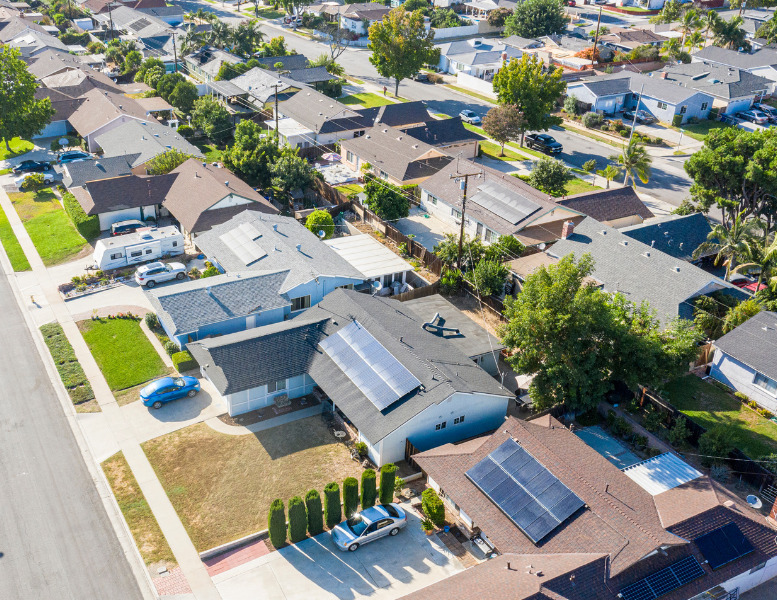
As the world pivots towards sustainable energy solutions, the United States is witnessing a remarkable surge in solar panel adoption. As a result, a common question asked is how many Americans have solar panels.
With over 4,227,503 million US homes sporting rooftop solar panels as of February 2024, the landscape of American energy consumption is undergoing a significant transformation.

Sources: SEIA , Ohm Analytics, Wood Mackenzie
This shift is not just about embracing green energy; it’s a collective move to slash electricity bills and minimize environmental footprints.
Table of Contents
How Many Homes In The USA Have Solar Panels
California’s 1.8 million solar installations are nearly tenfold those of Arizona, the second-largest state in terms of solar installs. This massive disparity underscores California’s role and its vast potential for solar energy, driven by once-supportive policies, significant investment, and an ideal climate.
Unfortunately, recent policy changes have hindered growth in the state as of 2024.
- California 1,866,359
- Arizona 290,786
- New York 202,406
- Florida 195,136
- New Jersey 181,294
- Massachusetts 158,723
- Colorado 134,729
- Nevada 110,687
- Maryland 99,504
- Hawaii 96,622
Arizona shines as the second-ranking state over 290,000 solar homes, leveraging its abundant sunshine to harness solar energy effectively. The state’s commitment to expanding solar capacity is evident in its growing number of installations, making it a national leader in solar energy production. Arizona’s success story is a testament to the viability of solar power in regions blessed with extensive sunlight.
New York follows, setting an example for the northeastern United States with its aggressive renewable energy targets and robust solar incentive programs. Despite its more varied climate, the state’s efforts to increase solar adoption illustrate the broad applicability of solar solutions across different geographic and climatic conditions.
Florida, the “Sunshine State,” naturally ranks among the top solar states. Thanks to favorable weather, evolving policy frameworks, and growing public and private investment in solar technology, its vast solar potential is increasingly being tapped.
New Jersey might surprise some, but its position as a top solar state is well-earned. With one of the most aggressive solar renewable energy certificate (SREC) markets and supportive state policies, New Jersey has made significant strides in solar installations, benefiting both residential and commercial sectors.
Massachusetts has distinguished itself through innovative policies and incentive programs encouraging solar adoption. The state’s commitment to renewable energy has made it a leader in solar installations, demonstrating that even states with less than ideal solar conditions can substantially contribute to the solar landscape.
Colorado’s natural beauty is matched by its solar achievements. With a strong environmental ethos and abundant sunshine, Colorado has embraced solar energy, making significant investments in solar installations across the state.
Nevada’s vast deserts are now home to more than just natural beauty; they are also the site of booming solar energy projects. The state’s commitment to renewable energy is evident in its rapid solar growth, fueled by utility-scale projects and residential installations.
Maryland’s strategic initiatives to promote solar energy have positioned it as a leader on the East Coast. The state’s renewable energy portfolio standard (RPS) and tax incentives have spurred impressive growth in solar installations, making solar energy an increasingly common sight across Maryland.
Lastly, Hawaii’s unique island environment and high electricity costs have made it a natural fit for solar energy. The state has aggressively pursued solar energy adoption, achieving one of the highest per capita rates of solar installations in the country. Hawaii’s success highlights the critical role of solar power in achieving energy independence and sustainability.
10 States with High Growth Potential
- Connecticut 87,137
- Utah 71,815
- Texas 71,146
- Pennsylvania 63,518
- Illinois 59,376
- New Mexico 52,409
- Virginia 44,954
- North Carolina 44,177
- Oregon 40,974
- Washington 40,167
Across the United States, states like Utah, Texas, Pennsylvania, Illinois, New Mexico, Virginia, North Carolina, Oregon, and Washington embrace solar energy, each showcasing unique strengths and initiatives.
Utah and Texas, with their ample sunshine, are expanding their solar footprint through both residential and utility-scale projects. States like Pennsylvania and Illinois are leveraging supportive policies to grow their solar installations, focusing on diversifying their energy portfolios.
New Mexico and Virginia highlight the Southwest and Southeast’s potential with aggressive solar project pursuits backed by favorable policies.
North Carolina stands out for its significant investment in solar farms, becoming a regional leader. At the same time, Oregon and Washington overcome less sunny climates with innovative technologies and programs to boost solar efficiency.
These states and Connecticut’s continued push for residential and community solar projects illustrate a nationwide commitment to solar energy, underscoring its importance in America’s transition to renewable energy sources.
Early Stage States
- South Carolina 33,273
- Louisiana 27,738
- Missouri 19,700
- Idaho 19,421
- Michigan 19,089
- New Hampshire 17,699
- Ohio 17,598
- Minnesota 14,189
- Washington, DC 14,109
- Rhode Island 12,902
- Arkansas 12,641
- Delaware 12,515
- Wisconsin 12,139
- Iowa 11,386
- Maine 10,005
- Vermont 9,337
- Indiana 9,022
- Oklahoma 8,627
- Georgia 6,291
- Kansas 5,915
- Montana 5,562
- Kentucky 5,350
Low Traction States
- West Virginia 2,827
- Alaska 2,432
- Nebraska 2,289
- Wyoming 2,286
- Mississippi 943
- South Dakota 161
- Tennessee 72
- North Dakota 68
Total US Solar Homes 4,227,503
Sources: SEIA , Ohm Analytics, Wood Mackenzie
What Percentage of US homes have solar?
As of 2024, the United States has witnessed a notable advancement in solar energy adoption within the residential sector, with 4.2 million single-family homes equipped with solar installations out of 84.69 million eligible homes.
This represents approximately 4.96% of all single-family homes nationwide, marking a significant milestone in the nation’s shift towards renewable energy sources.
While seemingly modest, this percentage signifies a robust movement towards sustainability and energy independence among American households.
It reflects the increasing accessibility and affordability of solar technology alongside a growing consciousness among homeowners about solar energy’s environmental and economic benefits.
How many total solar panels are in the US?
With 4.2 million American homes equipped with solar panels as of 2024, and an average installation ranging between 25 to 30 solar panels per rooftop, the total number of solar panels adorning residential roofs across the country is estimated to be between 105 and 126 million solar panels in total.
This impressive figure highlights the substantial footprint of residential solar energy within the national energy landscape.
Future Projections
Looking ahead, the solar market is poised for even greater expansion.

Predictions suggest a significant increase in homeowners opting for solar in the next decade, with a vast number of single-family homes eligible for solar installations.
This potential growth is a harbinger of solar energy’s central role in America’s energy future.
Cost Reduction and Accessibility
A pivotal factor in solar’s ascendancy is the dramatic reduction in costs.
An 80% decrease since 2010 has made solar installations an economically viable option for a broader population segment, enhancing its accessibility and adoption.

Conclusion
In conclusion, the landscape of solar energy in the United States has reached a significant milestone in 2024, with 4.2 million homes adopting solar systems, translating into an estimated 105 to 126 million solar panels installed nationwide.
This remarkable achievement signifies the individual homeowner’s commitment to sustainability and energy independence and marks a pivotal contribution to the country’s green energy capabilities.
With every solar panel installed, the nation moves closer to realizing its vision of a renewable energy-dominated landscape, setting a global example in the transition towards a greener, more resilient energy system.


